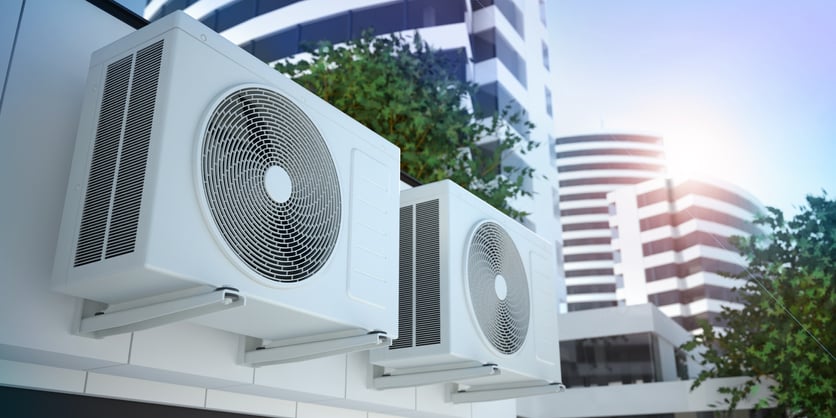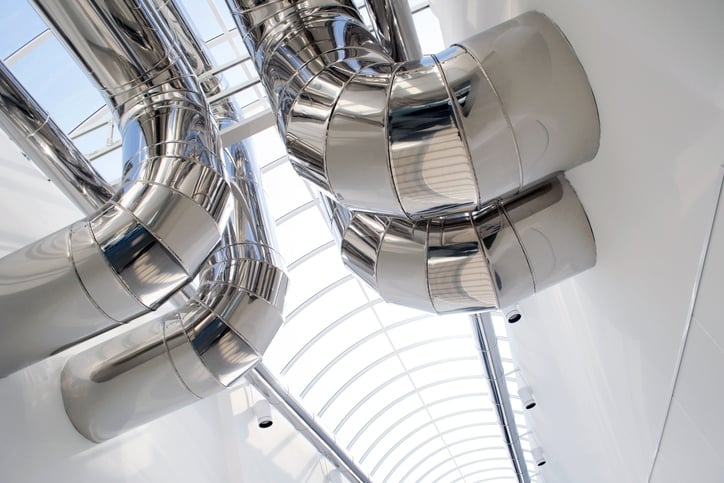HVAC Indoor Air Quality | The Critical Role of CO2 Sensors

Thanks to a global pandemic, the importance of indoor air quality (IAQ) is taking center stage in many applications more than it ever has.
However, IAQ has been a crucial consideration for HVAC system design and performance long before COVID-19 was even a thought.
A mainstay of HVAC indoor air quality management, CO2 sensors are one of the most important monitoring devices in any system. Checking the air for a gas that is a natural byproduct of breathing and is harmful in high concentrations, these sensors provide vital data on ventilation effectiveness and occupancy levels.
While CO2 sensors don’t always get the same level of attention (something that is changing) as other indoor air quality sensors in HVAC monitoring systems, they remain one of the most important components.
The Unquestionable Importance of Indoor Air Quality
For advanced indoor climate control, there’s arguably no more important element than HVAC indoor air quality. Sure, people can immediately tell when a space becomes too hot or too cold. But things that impact IAQ can be harmful and often go unnoticed.
The health implications of poor IAQ are profound. Inadequate ventilation and filtration can lead to a build-up of pollutants, including volatile organic compounds (VOCs), particulates, CO2, and microbial contaminants. These pollutants can trigger a range of health issues, from headaches and eye irritation to more severe respiratory diseases. In settings like offices and schools, the impact of poor IAQ on cognitive functions, including concentration and decision-making, can be significant.
CO2 as an HVAC Indoor Air Quality Indicator
Carbon dioxide is among one of the oldest – yet most important – indicators that HVAC indoor air quality systems monitor. CO2 concentrations have been used for decades to assess a space’s IAQ and ventilation effectiveness.
While CO2 isn’t considered a pollutant in the same way that VOCs are, its presence in enclosed spaces does pose a threat to health and IAQ in many of the same ways.
When reaching levels over 1000 parts per million (ppm), high CO2 concentrations can lead to discomfort and health issues such as drowsiness and decreased cognitive function.
At the same time, high CO2 levels can correlate with the presence of other pollutants in a space. In simplest terms, increased CO2 concentrations usually mean there’s poor ventilation and a good chance that other indoor air pollutants and contaminants have accumulated as well.
CO2 Sensors | Indoor Air Quality and HVAC Systems
As with any type of metric, there’s more than one way to measure CO2 levels in a space. Thus, there are plenty of sensor types available for HVAC systems:
- Metal oxide semiconductor (MOS) sensors
- Electrochemical sensors
- Chemical sensors
- Photoacoustic sensors
The most common type of CO2 sensor used in HVAC system design is the Non-Dispersive Infrared (NDIR) sensor. This sensor type is favored for its high accuracy and reliability. NDIR sensors operate based on the principle that CO2 molecules absorb specific light frequencies characteristic of their structure. The basic design of an NDIR sensor includes an infrared light source, a sample chamber for the air, an infrared filter, and an infrared detector. The CO2 concentration in a space is determined by measuring the amount of infrared light absorbed by the CO2 in the air passing through the sample chamber.
NDIR sensors can be broken down into two categories, both of which are nuanced and are better suited for certain applications:
- Single-Channel NDIR Sensors: These sensors utilize a single wavelength detection design coupled with sophisticated firmware algorithms to maintain sensor accuracy over the life of the sensor.
- Dual-Channel NDIR Sensors: These include two independent wavelength detection measurements as a method of sensor drift compensation. The second reference channel helps compensate for any changes in the light source or sensor over time, enhancing the accuracy and reliability of the measurements.
CO2 Sensor Integration: 6 Challenges & Considerations
In a perfect world, adding advanced CO2 sensor technology wouldn’t require any additional thought or accommodations. You’d simply choose the sensor you want, add it where needed, and go on with life.
While advanced sensor integration to an HVAC system – both new and existing – isn’t a new form of rocket science or trying to crack cold fusion, it still requires some forethought and careful consideration. With HVAC CO2 sensors, effective integration means considering:
- Compatibility with existing HVAC systems
- Sensor accuracy and calibration
- Single vs. dual channel technology
- Sensor placement and coverage
- Communication protocols
- New IAQ regulations
1. Compatibility with Existing HVAC Systems
Adding advanced sensor technology of any sort to an existing system isn’t always plug-and-play. In fact, particularly with older systems, this is rarely the case.
The simple fact is older HVAC systems were not designed with the advanced connectivity and compatibility required to interface seamlessly with modern CO2 sensor modules. Compatibility issues can arise due to differences in communication protocols, such as I2C, UART, PWM, etc.
This mismatch can lead to issues in accurate data transmission and sensor functioning. The technological disparity between new sensors and old systems might require additional interfaces or software for proper integration. In some cases, it means using new hardware, such as wireless & battery-operated equipment.
2. Sensor Accuracy and Calibration
During its useful life, CO2 sensors can lose can drift– it’s no different than any other piece of technology that’s used constantly. This drift can lead to a gradual decrease in the sensor's ability to accurately measure CO2 levels.
Though no sensor is made to last forever, choosing the right sensor and the right calibration protocol helps ensure the device remains functional and accurate for as long as possible. More than that, proper sensor selection and maintenance can lead to enhanced energy savings and improved air quality.
Reminder: One of the biggest mistakes we’ve seen in HVAC system design is integrating sensors in spots that become inaccessible. Even wireless sensor technology has its range limits. It goes without saying: be mindful of sensor placement in your system setup.
3. Single Vs. Dual Channel Technology
Back to the choices you have for NDIR CO2 sensor technology – single channel vs. dual channel.
In simplest terms, both types of NDRI sensors have applications they’re best suited for because of their functionality. With single channel sensors, you have to be considerate of the environment it’s operating in – there should only be periodic drops to ambient C02 levels to no less than 400 ppm or else it won’t work. They’re ideal in HVAC systems in movie theaters, exhibition halls, or automotive applications.
With more technology behind them, dual channel sensors are ideal for more demanding situations where CO2 levels don’t change much, such as being installed in greenhouses, hospitals, or continuously occupied buildings. They should not be installed in places where ambient CO2 levels ever go below 400 ppm.
4. CO2 Sensor Placement and Coverage
Speaking of sensor placement …
Beyond accessibility, there's arguably no more important consideration than CO2 sensor placement. It’s simple – if the sensors are in less-than-ideal (or outright wrong) places, they can’t do their jobs.
A few tips on placement:
- CO2 sensors should typically be placed within the breathing zone, which is about 4-6 feet from the floor.
- Sensors should be positioned away from doors, windows, or direct ventilation sources to avoid skewed readings due to external air.
- In larger buildings with varied environments, such as offices, schools, or commercial spaces, it's important to have sensors in different zones. This ensures that CO2 levels are accurately monitored in all areas, accounting for differences in occupancy and activity levels.
- In areas where CO2 usage is high or where CO2 is stored, like grow rooms or storage areas, sensors might be placed lower, closer to potential leak sources. In contrast, in general office or residential areas, the placement would be in the breathing zone as mentioned above.
5. Communication Protocols
It’s one thing for a sensor to take a reading, but it’s another for its ability to interface with the HVAC’s control system.
Most HVAC systems still rely on analog communication protocols. Analog sensors typically provide a linear output, commonly in the ranges of 0-5 volts or 0-10 volts. This method of communication has been reliable and widely adopted due to its simplicity and ease of integration with various HVAC systems. However, the market is shifting toward digital communication protocols. Digital communications offer several advantages over analog, including higher accuracy, the ability to carry more detailed data, and improved noise immunity. And digital is becoming more important as more property owners are turning to building automation systems, which – you guessed it – are digital.
6. New IAQ Regulations
The regulatory landscape regarding IAQ and CO2 monitoring systems is changing.
Especially since the pandemic, new standards and guidelines are being implemented by both governments and industry groups setting more stringent requirements for HVAC system performance. At the same time, old regulations – many of which are industry standards, such as the ANSI/ASHRAE Standards 62.1 and 62.2 – are seeing updates.
Regardless of the reason why, these new rules and regs are here to stay and impact HVAC system design.
Monitoring CO2 for Better HVAC Indoor Air Quality
Indoor air quality is now seeing renewed importance in building management.
No matter how HVAC systems or regulations evolve, CO2 monitoring will always be a major component of keeping indoor environments safe for occupants. Regardless of how things change, integrated HVAC system advanced sensor technology makes it easier and more efficient to keep CO2 levels in check and spaces properly ventilated.
Bring Advanced CO2 Sensor Technology to Your HVAC Systems
Speak with one of our sensor application engineers:




